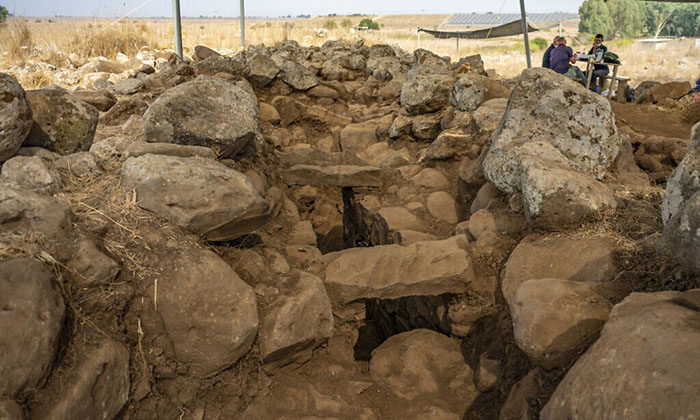
The Israel Antiquities Authority excavation at the Golan’s Hispin, where a circa 11th century fort was discovered. (Yaniv Berman, Israel Antiquities Authority)
RELEASE – A fortified structure from the time of King David was exposed for the first time in archaeological excavations carried out by Israel Antiquities Authority in Hispin in the Golan.
The structure was exposed in archaeological excavations prior to the construction of a new neighborhood in Hispin by the Ministry of Housing and Construction and the Golan Regional Council.
The archaeological excavation of the site was performed primarily by local residents and youth.
It is possible that the fort was manned by the Geshurites, who according to the Bible, ruled in the Southern Golan, and carried out diplomatic relations with King David and the Davidic Dynasty.
“The structure was built at a strategic location on the small hilltop, above the El-Al canyon, overlooking the region, at a spot where it was possible to cross the river,” the excavation directors, Barak Zin and Enno Bron, explained.
During the excavation, another rare and exciting find was discovered, “a large basalt stone with a schematic engraving of two-horned figures with outspread arms.”
The IAA notes that a figure carved on a cultic stone stele was in 2019 found in the Bethsaida Expedition Project, directed by Dr.Rami Arav of Nebraska University, at Bethsaida just north of the Sea of Galilee.
The stele, depicting a horned figure with outspread arms, was erected next to a raised platform (bama) adjacent to the city gate. This scene was identified by Arav as representing the Moon-God Cult. The Hispin stone was located on a shelf next to the entrance, and not one, but two figures were depicted on it.
According to the archaeologists, it is possible that a person who saw the impressive Bethsaida stele, decided to create a local copy of the royal stele.
The fortified city of Bethsaida is considered by scholars, to be the capital of the Aramean Kingdom of Geshur, that ruled the central and southern Golan 3000 years ago.
Cities of the Kingdom of Geshur are known along the Sea of Galilee shore, including Tel En Gev, Tel Hadar, and Tel Sorag, but sites are hardly known in the Golan. This unique fortified complex raises new research issues on the settlement of the Golan in the Iron Age.
Following this discovery, changes in the development plans will be carried out together with the Ministry of Housing and Construction, in order that the unique fortified complex will not be damaged.
The complex will be developed as an open area along the El-Al river bank, where educational-archaeological activities will be carried out, as part of the cultural heritage and a link with the past.
“We are astonished by these rare findings and grateful for the opportunity to experience work in the field and strengthen the young generation’s bonds with their roots,” Israel Antiquities Authority said.

